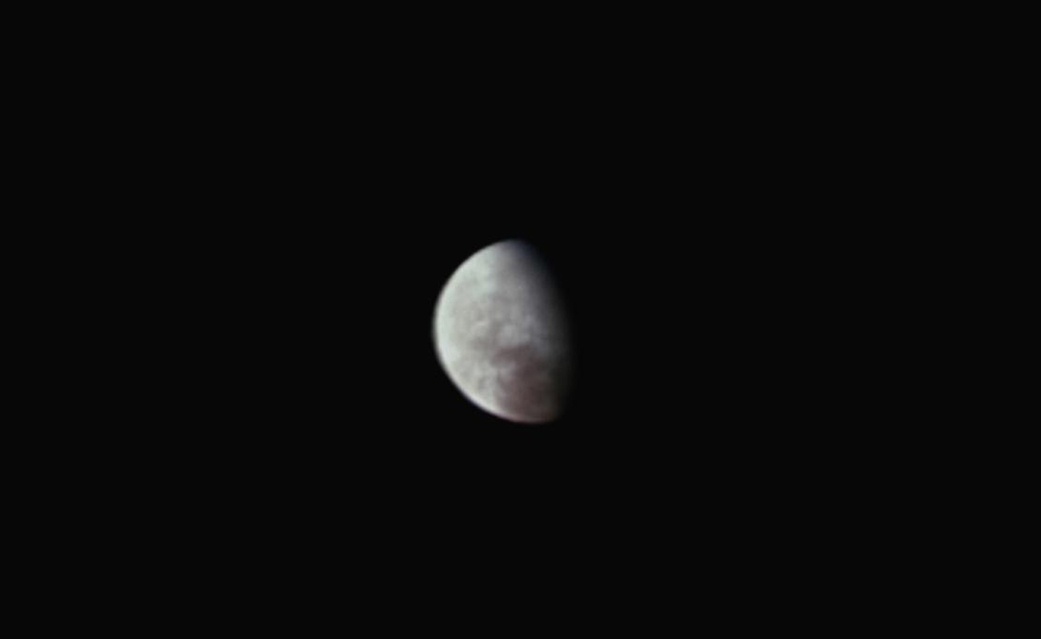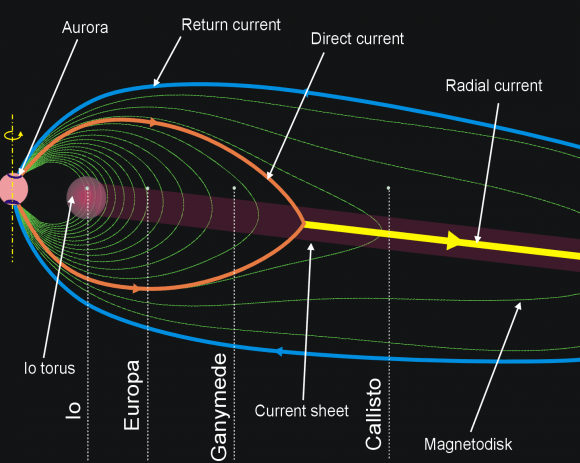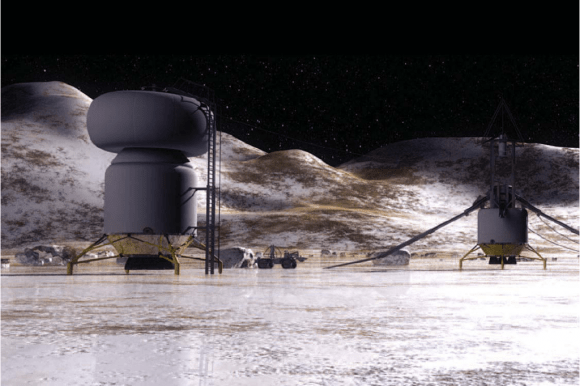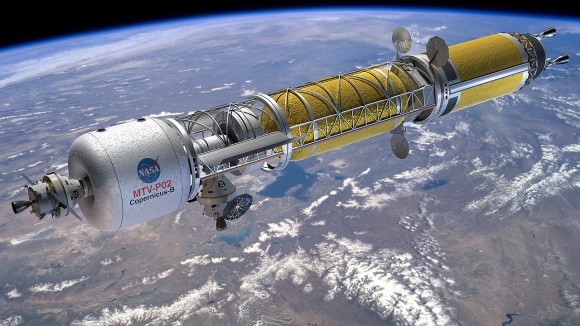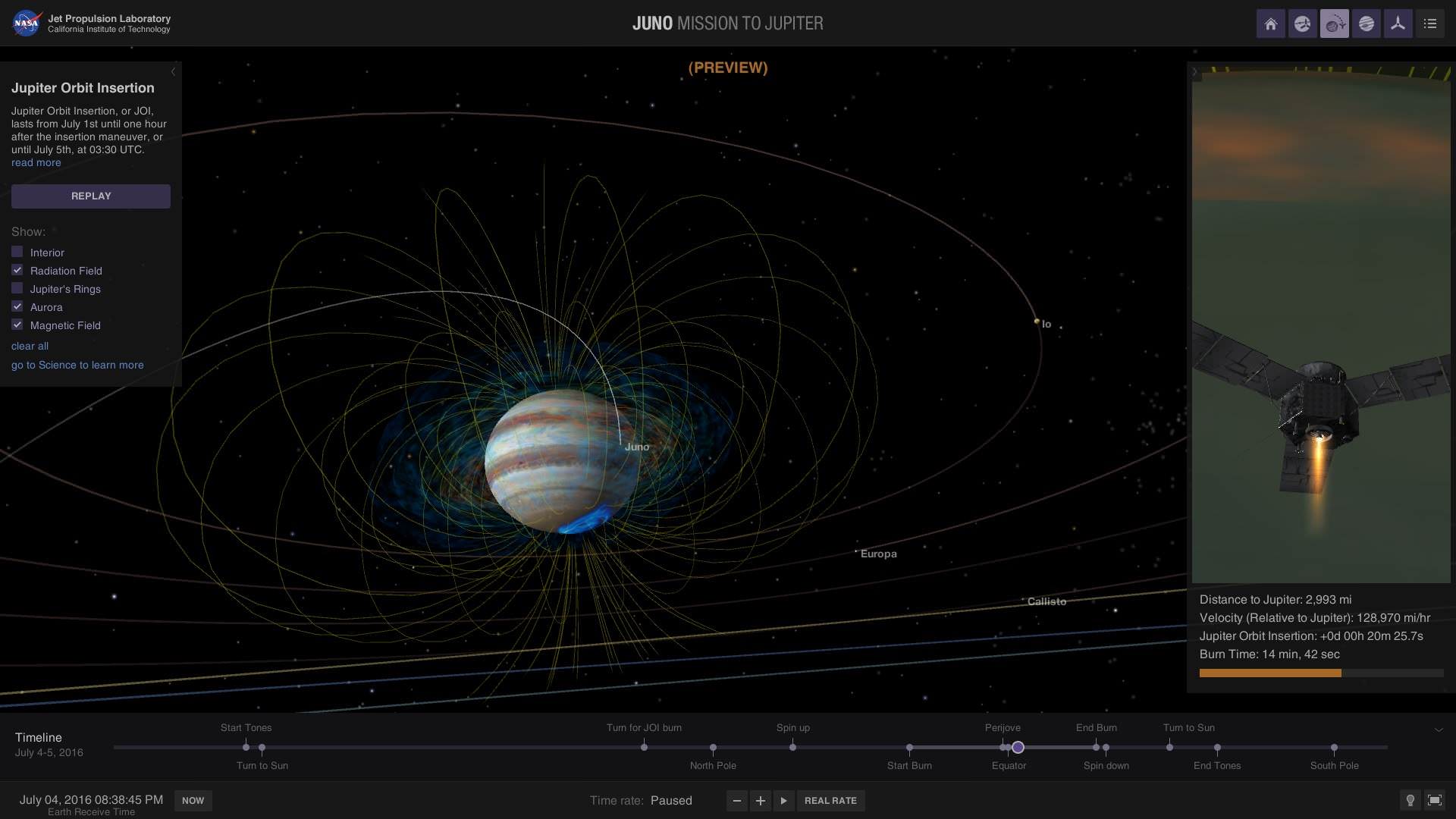This next week will mark a scientifically valuable achievement for NASA’s Juno mission, as the pioneering spacecraft is slated to fly within 358 kilometers (222 miles) of Jupiter’s icy moon Europa on September 29 at 5:36 a.m. EDT (2:36 a.m. PDT) as part of its extended mission to explore the Jupiter system. A flyby this close to Europa’s surface will allow Juno to acquire some of the highest-resolution images ever taken of the icy moon. For context, the last mission to explore Europa in depth was NASA’s Galileo spacecraft, which got within 351 kilometers (218 miles) of the surface on January 3, 2000.
Continue reading “NASA’s Juno To Skim the Surface of Jupiter’s Icy Moon Europa”Will Europa finally answer, ‘Are we alone?’
While NASA’s much-lauded Space Launch System stands ready for its maiden flight later this month with the goal of sending astronauts back to the Moon in the next few years, our gazes once again turn to the stars as we continue to ask the question that has plagued humankind since time immemorial: Are we alone? While there are several solar system locales that we can choose from to conduct our search for life beyond Earth, to include Mars and Saturn’s moons, Titan and Enceladus, one planetary body orbiting the largest planet in the solar system has peaked the interest of scientists since the 1970s.
Continue reading “Will Europa finally answer, ‘Are we alone?’”Why Visit Just one Moon When you Could Explore Them all?
The Solar System’s moons are intriguing objects for exploration. Especially moons like Europa and Enceladus. Their subsurface oceans make them primary targets in the search for life.
But why not send one spacecraft to visit several moons? NASA’s about to launch its Lucy mission which will visit 8 separate asteroids. Could the same be done for a mission to multiple moons?
For a spacecraft to do that, it would have to do a little dance with the notorious three-body problem, which makes a stubborn partner. A new study presents a possible way to do that.
Continue reading “Why Visit Just one Moon When you Could Explore Them all?”Ganymede in Infrared Taken During Juno’s Most Recent Flyby
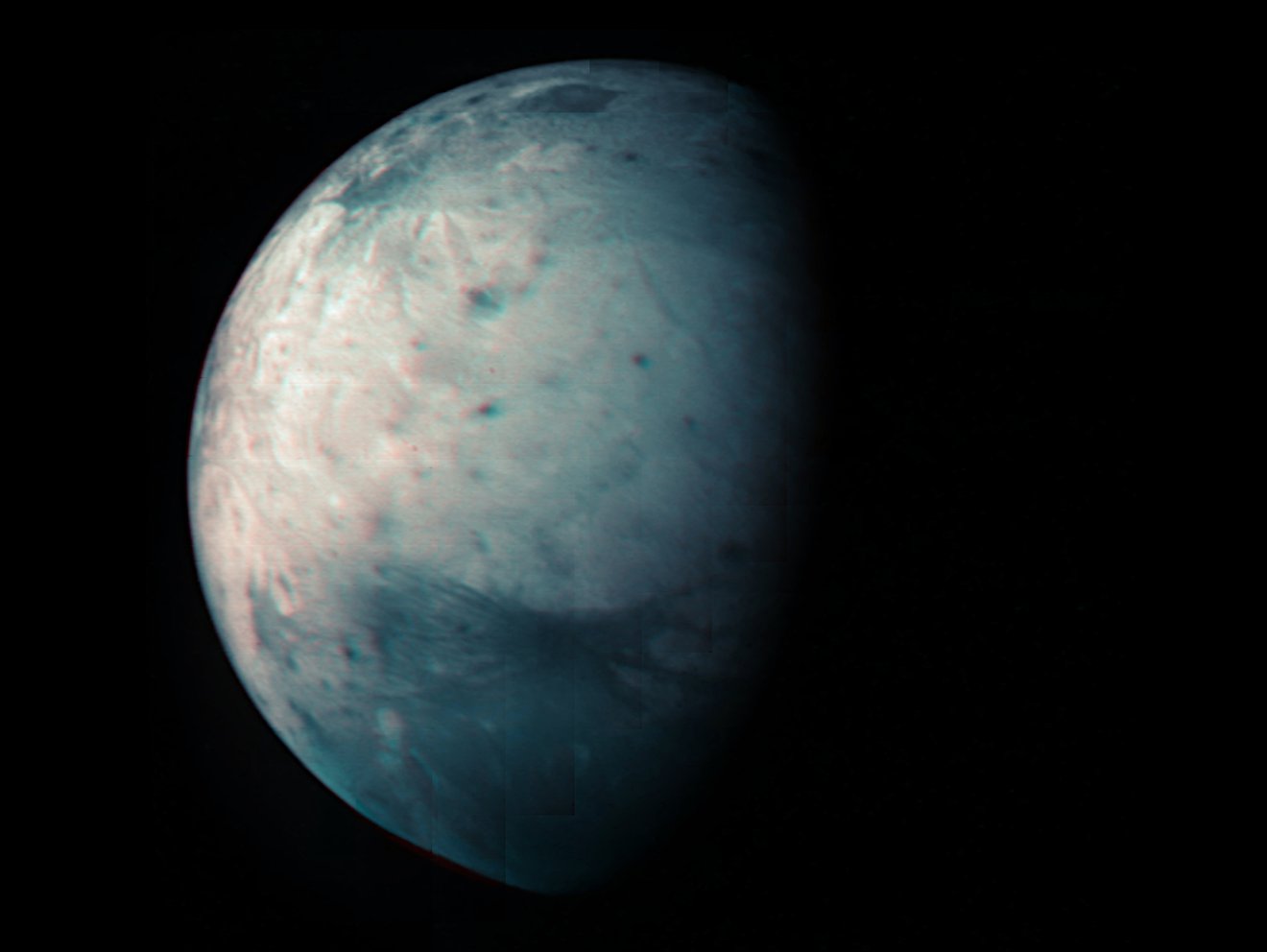
On July 20th, 2021, NASA’s Juno spacecraft conducted a flyby of Jupiter’s (and the Solar System’s) largest moon, Ganymede. This close pass was performed as part of the orbiter’s thirty-fourth orbit of the gas giant (Perijove 34), which saw the probe come within 50,109 km (31,136 mi) of the moon’s surface. The mission team took this opportunity to capture images of Ganymede’s using Juno’s Jovian Infrared Auroral Mapper (JIRAM).
These were combined with images acquired during two previous flybys to create a new infrared map of Ganymede’s surface, which was released in honor of the mission’s tenth anniversary (which launched from Earth on Aug. 5th, 2011). This map and the JIRAM instrument could provide new information on Ganymede’s icy shell and the composition of its interior ocean, which could shed led on whether or not it could support life.
Continue reading “Ganymede in Infrared Taken During Juno’s Most Recent Flyby”Thanks to Gaia, we Now Know Exactly How Big Europa is
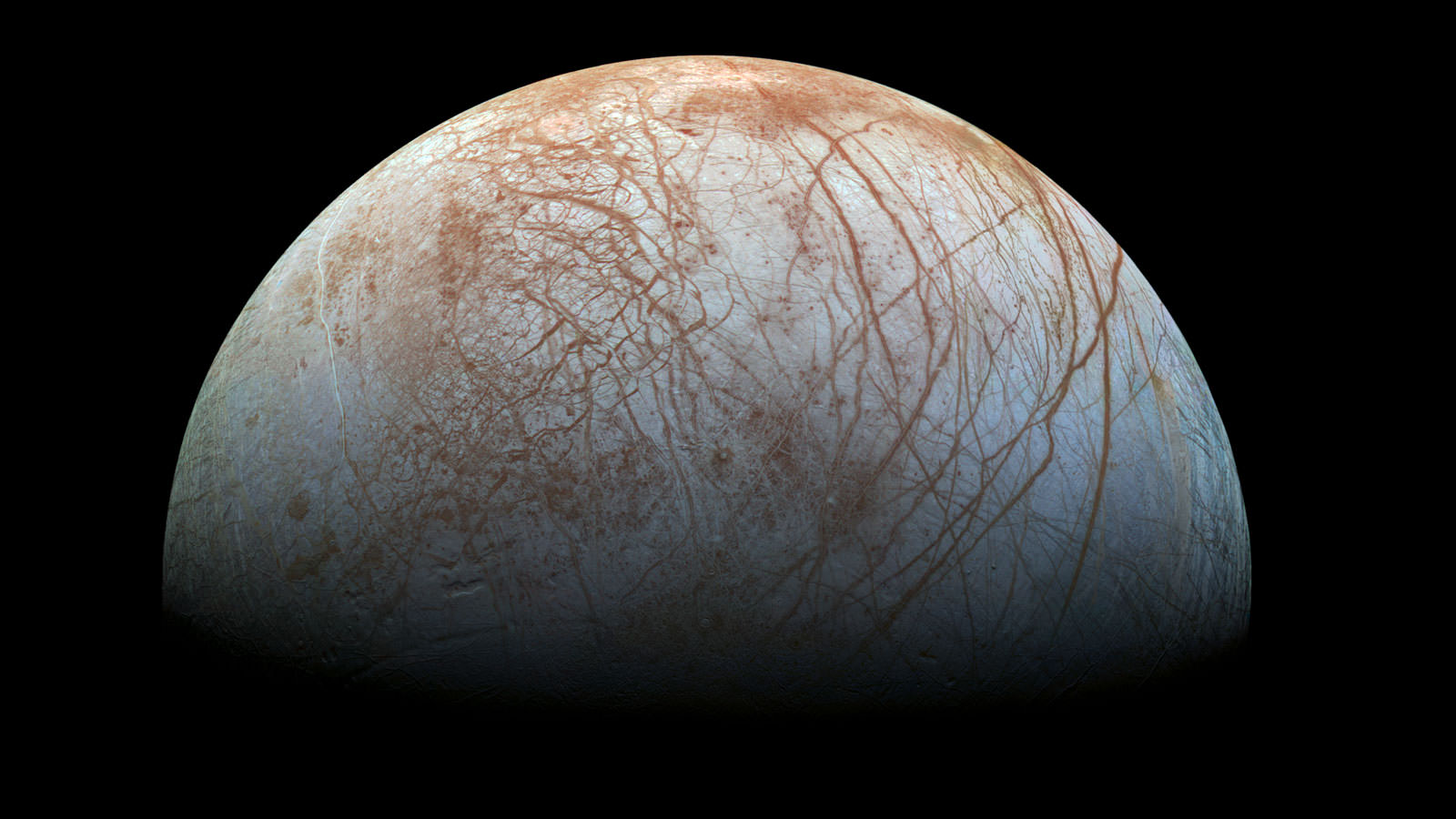
Jupiter’s moon Europa continues to be a source of wonder and scientific intrigue. As one of the four Galilean Moons (so-named because of their founder, Galileo Galilee), Europa is one of Jupiter’s largest satellites and is considered one of the best bets for finding extraterrestrial life in the Solar System. And recently, it joined its cousins (Io and Callisto) in passing in front of a star.
This type of rare event (a stellar occultation) allows astronomers to conduct unique observations of a celestial body. In Europa’s case, the occultation took place in 2017 and allowed astronomers to make more precise measurements of Europa’s size, its position relative to Jupiter, and its true shape. All this was made possible by the ESA’s Gaia Observatory, which let astronomers know exactly when and where to look for the moon.
Continue reading “Thanks to Gaia, we Now Know Exactly How Big Europa is”How Do We Settle on Jupiter’s Moons?
Welcome back to our series on Settling the Solar System! Today, we take a look at the largest of the Jovian Moons – Io, Europa, Ganymede and Callisto!
In 1610, Galileo Galilei became the first astronomer to discover the large moons of Jupiter, using a telescope of his own design. As time passed, these moons – Io, Europa, Ganymede, and Callisto – would collectively come to be referred to as the Galilean Moons, in honor of their discoverer. And with the birth of space exploration, what we’ve come to know about these satellites has fascinated and inspired us.
For example, ever since the Pioneer and Voyager probes passed through the system decades ago, scientists have suspected that moons like Europa might be our best bet for finding life in our Solar System beyond Earth. And because of the presence of water ice, interior oceans, minerals, and organic molecules, it has been speculated that humanity might establish colonies on one or more of these worlds someday.
Examples in Fiction:
The concept of a colonized Jovian system is featured in many science fiction publications. For instance, Robert A. Heinlein’s novel Farmer in the Sky (1953) centers on a teenage boy and his family moving to Ganymede. The moon is in the process of being terraformed in the story, and farmers are being recruited to help turn it into an agricultural colony.
In the course of the story, it is mentioned that there are also efforts to introduce an atmosphere on Callisto. Many of his Heinlein’s other novels include passing mentions of a colony on Ganymede, including The Rolling Stones (1952), Double Star (1956), I Will Fear No Evil (1970), and the posthumously-written Variable Star (2006).
In 1954, Poul Anderson published a novella titled The Snows of Ganymede (1954). In this story, a party of terraformers visits a settlement on Ganymede called X, which was established two centuries earlier by a group of American religious fanatics.
In Arthur C. Clarke’s Space Odyssey series, the moon of Europa plays a central role. In 2010: Odyssey Two (1982) an ancient race of advanced aliens are turning the moon into a habitable body by converting Jupiter into a second sun. The warmth of this dwarf star (Lucifer) causes the surface ice on Europa to melt, and the life forms that are evolving underneath are able to emerge.
In 2061: Odyssey Three, Clarke also mentions how Lucifer’s warmth has caused Ganymede’s surface to partially sublimate, creating a large equatorial lake. Isaac Asimov also used the moons of Jupiter in his stories. In the short stories “Not Final!” (1941) and “Victory ‘Unintentional'” (1942), a conflict arises between humans living on Ganymede and the inhabitants of Jupiter.
In Philip K. Dick’s short-story The Mold of Yancy (1955), Callisto is home to a colony where the people conform to the dictates of Yancy, a public commentator who speaks to them via public broadcasts. In Bruce Sterling’s Schismatrix (1985), Europa is inhabited by a faction of genetically-engineered posthumans that are vying for control of the Solar System.
Alastair Reynolds’s short story “A Spy in Europa” depicts colonies built on the underside of Europa’s icy surface. Meanwhile, a race of genetically-altered humans (called the “Denizens”) are created to live in the subsurface ocean, close to the core-mantle boundary where hydrothermal vents keep the water warm and the native life forms live.
Kim Stanley Robinson’s novels Galileo’s Dream (2009) and 2312 (2012) feature colonies on Io, where settlements are adapted to deal with the volcanically active, hostile surface. The former novel is partly set on Callisto, where a massive city called Valhalla is built around the concentric rings of the moon’s giant crater (also mentioned in 2312).
In Robinson’s The Memory of Whiteness (1985), the protagonists visit Europa, which hosts large human colonies who live around pools of melted ice. And in his novel Blue Mars (1996), Robinson makes a passing description of a flourishing colony on Callisto.
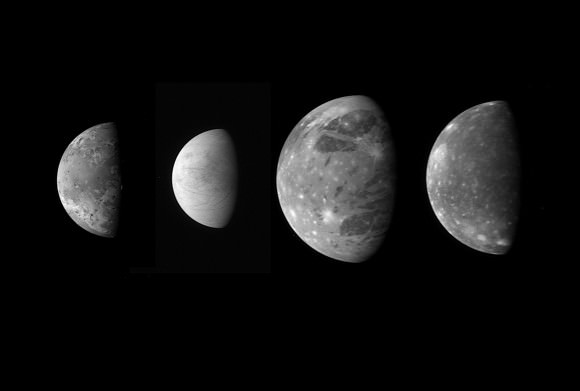
Proposed Methods:
Since the Voyager probes passed through the Jovian system, several proposals have been made for crewed missions to Jupiter’s moons and even the creation of settlements. For instance, in 1994, the private spaceflight venture known as the Artemis Project was established with the intent of colonizing the Moon in the 21st century.
However, in 1997, they also drafted plans to colonize Europa, which called for igloos to be established on the surface. These would serve as based for scientists who then drill down into the Europan ice crust and explore the sub-surface ocean. This plan also discussed the possible use of “air pockets” in the ice sheet for long-term human habitation.
In 2003, NASA produced a study called Revolutionary Concepts for Human Outer Planet Exploration (HOPE) which addressed future exploration of the Solar System. Because of its distance from Jupiter, and therefore low exposure to radiation, the target destination in this study was the moon Callisto.
The plan called for operations to begin in 2045. These would begin with the creation of a base on Callisto, where science teams would be able to teleoperate a robotic submarine that would be used to explore Europa’s internal ocean. These science teams would also excavate surface samples near their landing site on Callisto.
Last, but not least, the expedition to Callisto would establish a reusable surface habitat where water ice could be harvested and converted into rocket fuel. This base could therefore serve as a resupply base for all future exploitation missions in the Jovian system.
Also in 2003, NASA reported that a manned mission to Callisto might be possible in the 2040s. According to a joint-study released by the Glenn Research Center and the Ohio Aerospace Institute, this mission would rely on a ship equipped with Nuclear-Electric Propulsion (NEP) and artificial gravity, which would transport a crew on a 5-year mission to Callisto to establish a base.
In his book Entering Space: Creating a Spacefaring Civilization (1999), Robert Zubrin advocated mining the atmospheres of the outer planets – including Jupiter – to obtain Helium-3 fuel. A base on one or more of the Galilean moons would be necessary for this. NASA has also speculated on this, citing how it could yield limitless supplies of fuel for fusion reactors here on Earth and anywhere else in the Solar System where colonies exist.
In the 2000s, the Lifeboat Foundation – a non-profit organization dedicated to the preservation of humanity – was established. In 2012, they released a study titled “Colonizing Jupiter’s Moons: An Assessment of Our Options and Alternatives“, which considered the colonization of the Galilean moons as a potential alternative to colonies on the Moon or Mars.
In October of 2012, Elon Musk unveiled his concept for an Mars Colonial Transporter (MCT), which was central to his long-term goal of colonizing Mars. At the time, Musk stated that the first unmanned flight of the Mars transport spacecraft would take place in 2022, followed by the first manned MCT mission departing in 2024.
In September 2016, during the 2016 International Astronautical Congress, Musk revealed further details of his plan, which included the design for an Interplanetary Transport System (ITS) and estimated costs. This system, which was originally intended to transport settlers to Mars, had evolved in its role to transport human beings to more distant locations in the Solar System – including Europa and other Jovian moons.
Potential Benefits:
Establishing colonies on the Galilean moons has many potential benefits for humanity. For one, the Jovian system is incredibly rich in terms of volatiles – which include water, carbon dioxide, and ammonia ices – as well as organic molecules. In addition, it is believed that Jupiter’s moons also contain massive amounts of liquid water.
For example, volume estimates placed on Europa’s interior ocean suggest that it may contain as much as 3 × 1018 m3 – three quadrillion cubic kilometers, or 719.7 trillion cubic miles – of water. This is slightly more than twice the combined volume of all of Earth’s oceans. In addition, colonies on the moons of Jupiter could enable missions to Jupiter itself, where hydrogen and helium-3 could be harvested as nuclear fuel.
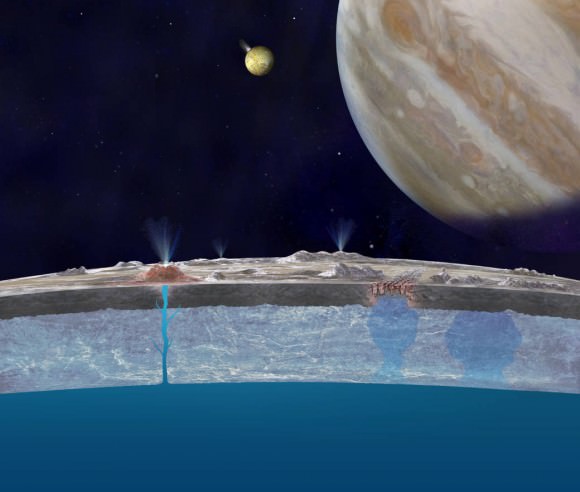
Colonies established on Europa and Ganymede would also allow for multiple exploration missions to be mounted to the interior oceans that these moons are believed to have. Given that these oceans are also thought to be some of the most likely locations for extra-terrestrial life in our Solar System, the ability to examine them up close would be a boon for scientific research.
Colonies on the moons of Io, Europa, Ganymede, and Callisto would also facilitate missions farther out into the Solar System. These colonies could serve as stopover points and resupply bases for missions heading to and from the Cronian system (Saturn’s system of moons) where additional resources could be harvested.
In short, colonies in the Jovian system would provide humanity with access to abundant resources and immense research opportunities. The chance to grow as a species, and become a post-scarcity one at that, are there; assuming that all the challenges can be overcome.
Challenges:
And of course, these challenges are great in size and many in number. They include, but are not limited to, radiation, the long-term effects of lower gravity, transportation issues, lack of infrastructure, and of course, the sheer cost involved. Considering the hazard radiation poses to exploration, it is appropriate to deal with this aspect first.
Io and Europa, being the closest Galileans to Jupiter, receive the most radiation of any of these moons. This is made worse by the fact that neither have a protective magnetic field and very tenuous atmospheres. As such, Io’s surface receives an average of about 3,600 rems per day, while Europa receives about 540 per day.
For comparison, people here on Earth are exposed to less than 1 rem a day (0.62 for those living in developed nations). Exposure to 500 rems a day is likely to be fatal, and exposure to roughly 75 in a period of a few days is enough to cause severe health problems and radiation poisoning.
Ganymede is the only Galilean moon (and only non-gas giant body other than Earth) to have a magnetosphere. However, it is still overpowered by Jupiter’s powerful magnetic field. On average, the moon receives about 8 rads of radiation per day, which is the equivalent of what the surface of Mars is exposed to in an average year.
Only Callisto is far enough from Jupiter that it is not dominated by its magnetic environment. Here, radiation levels only reach about 0.01 rems per day, just a fraction of what we are exposed to here on Earth. However, its distance from Jupiter means that it experiences its fair share of problems as well (not the least of which is a lack of tidal heating in its interior).
Another major issue is the long-term effects the lower gravity on these moons would have on human health. On the Galilean moons, the surface gravity ranges from 0.126 g (for Callisto ) to 0.183 g (for Io). This is comparable to the Moon (0.1654 g), but substantially less than Mars (0.376 g). And while the effects of low-g are not well-understood, it is known that the long-term effect of microgravity include loss of bone density and muscle degeneration.
Compared to other potential locations for colonization, the Jovian system is also very far from Earth. As such, transporting crews and all the heavy equipment necessary to build a colony would be very time-consuming, as would missions where resources were being transported to and from the Jovian moons.
To give you a sense of how long it would take, let’s consider some actual missions to Jupiter. The first spacecraft to travel from Earth to Jupiter was NASA’s Pioneer 10 probe, which launched on March 3rd, 1972, and reached the Jupiter system on December 3, 1973 – 640 days (1.75 or years) of flight time.
Pioneer 11 made the trip in 606 days, but like its predecessor, it was simply passing through the system on its way to the Outer planets. Similarly, the Voyager 1 and 2 probes, which were also passing through the system, took 546 days and 688 days, respectively. For direct missions, like the Galileo probe and the recent Juno mission, the travel time was even longer.
In the case of Galileo, the probe left Earth on October 18th, 1989, and arrived at Jupiter on December 7th, 1995. In other words, it took 6 years, 1 month, and 19 days to make it to Jupiter from Earth without flying by. Juno, on the other hand, launched from Earth on Aug. 5th, 2011, and achieved orbit around Jupiter on July 5th, 2016 – 1796 days, or just under 5 years.
And, it should be noted, these were uncrewed missions, which involved only a robotic probe and not a vessel large enough to accommodate large crews, supplies and heavy equipment. As a result, colony ships would have to be much larger and heavier, and would require advanced propulsion systems – like nuclear-thermal/nuclear-electric engines – to ensure they made the trip in a reasonable amount of time.
Missions to and from the Jovian moons would also require bases between Earth and Jupiter in order to provide refueling and resupplying, and cut down on the costs of individual missions. This would mean that permanent outposts would need to be established on the Moon, Mars, and most likely in the Asteroid Belt before any missions to Jupiter’s moons were considered feasible or cost-effective.
These last two challenges raise the issue of cost. Between building ships that have the ability to make the trip to Jupiter in a fair amount of time, established the bases needed to support them, and the cost of establishing the colonies themselves, the colonization of the Jovian moons would be incredibly expensive! Combined with the hazards of doing so, one has to wonder if its even worth it.
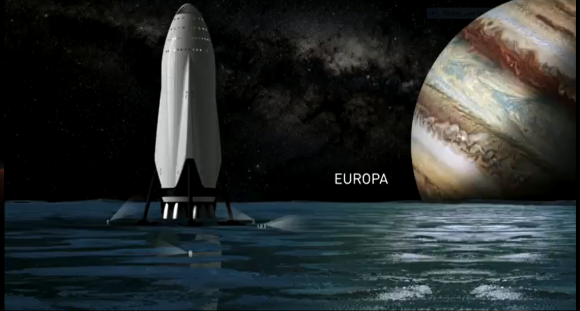
On the other hand, in the context of space exploration and colonization, the idea of establishing permanent human outposts on Jupiter’s moons makes sense. All of the challenges can be addressed, provided the proper precautions are taken and the right kind of resources are committed. And while it will have to wait until after similar colonies/bases are established on the Moon and Mars, it is not a bad idea as far as “next steps” go.
With colonies on any of the Galilean moons, humanity will have a foothold in the outer Solar System, a stopover point for future missions to Saturn and beyond, and access to abundant resources. Again, it all comes down to how much we are willing to spend.
We have written many interesting articles on colonization here at Universe Today. Here’s Why Colonize the Moon First?, How Do We Colonize Mercury?, How Do We Colonize Venus?, Colonizing Venus with Floating Cities, Will We Ever Colonize Mars?, and The Definitive Guide to Terraforming.
Astronomy Cast also has some interesting episodes on the subject. Check out Episode 95: Humans to Mars, Part 2 – Colonists, Episode 115: The Moon, Part 3 – Return to the Moon, Episode 381: Hollowing Asteroids in Science Fiction.
Sources:
How Many Moons are in the Solar System?
For millennia, human beings stared up at the night sky and were held in awe by the Moon. To many ancient cultures, it represented a deity, and its cycles were accorded divine significance. By the time of Classical Antiquity and the Middle Ages, the Moon was considered to be a heavenly body that orbited Earth, much like the other known planets of the day (Mercury, Venus, Mars, Jupiter, and Saturn).
However, our understanding of moons was revolutionized when in 1610, astronomer Galileo Galilei pointed his telescope to Jupiter and noticed ” four wandering stars” around Jupiter. From this point onward, astronomers have come to understand that planets other than Earth can have their own moons – in some cases, several dozen or more. So just how many moons are there in the Solar System?
In truth, answering that question requires a bit of clarification first. If we are talking about confirmed moons that orbit any of the planets of the Solar System (i.e. those that are consistent with the definition adopted by the IAU in 2006), then we can say that there are currently 207 known moons. If however, we open the floor to “dwarf planets” that have confirmed satellites, the number reached 220.
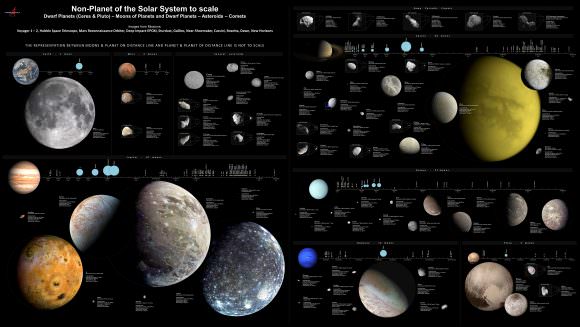
However, 479 minor-planet moons have also been observed in the Solar System (as of Dec. 2022). This includes the 229 known objects in the asteroid belt with satellites, six Jupiter Trojans, 91 near-Earth objects (two with two satellites each), 31 Mars-crossers, and 84 natural satellites of Trans-Neptunian Objects. And some 150 additional small bodies have been observed within the rings of Saturn. If we include all these, then we can say that the Solar System has 849 known satellites.
Inner Solar System:
The planets of the Inner Solar system – Mercury, Venus, Earth, and Mars – are all terrestrial planets, which means that they are composed of silicate rock and minerals that are differentiated between a metallic core and a silicate mantle and crust. For a number of reasons, few satellites exist within this region of the Solar System.
All told, only three natural satellites exist orbiting planetary bodies in the Inner Solar System – Earth and Mars. While scientists theorize that there were moons around Mercury and Venus in the past, it is believed that these moons impacted the surface a long time ago. The reason for this sparseness of satellites has a lot to do with the gravitational influence of the Sun.
Both Mercury and Venus are too close to the Sun to have grabbed onto a passing object or held onto rings of debris in orbit that could have coalesced to form a satellite over time. In Mercury’s case, it is also too weak in terms of its own gravitational pull to grab a satellite in its orbit. Earth and Mars were able to retain satellites, but mainly because they are the outermost of the Inner planets.
Earth has only one natural satellite, which we are familiar with – the Moon. With a mean radius of 1737 km (1,080 mi) and a mass of 7.3477 x 10²² kg, the Moon is 0.273 times the size of Earth and 0.0123 as massive, which is quite large for a satellite. It is also the second densest moon in our Solar System (after Io), with a mean density of 3.3464 g/cm³.
Several theories have been proposed for the formation of the Moon. The prevailing hypothesis today is that the Earth-Moon system formed as a result of an impact between the newly-formed proto-Earth and a Mars-sized object (named Theia) roughly 4.5 billion years ago. This impact would have blasted material from both objects into orbit, where it eventually accreted to form the Moon.
Mars, meanwhile, has two moons – Phobos and Deimos. Like our own Moon, both of the Martian moons are tidally locked to Mars, so they always present the same face to the planet. Compared to our Moon, they are rough and asteroid-like in appearance and also much smaller. Hence the prevailing theory is that they were once asteroids that were kicked out of the Main Belt by Jupiter’s gravity and were then acquired by Mars.
The larger moon is Phobos, whose name comes from the Greek word which means “fear” (i.e. phobia). Phobos measures just 22.7 km (14 mi) across and has an orbit that places it closer to Mars than Deimos. Compared to Earth’s own Moon — which orbits at a distance of 384,403 km (238,857 mi) away from our planet — Phobos orbits at an average distance of only 9,377 km (5,826.5 mi) above Mars.

Mars’ second moon is Deimos, which takes its name from the Greek word for panic. It is even smaller, measuring just 12.6 km (7.83 mi) across, and is also less irregular in shape. Its orbit places it much farther away from Mars, at a distance of 23,460 km (14,577 mi), which means that Deimos takes 30.35 hours to complete an orbit around Mars.
These three moons are the sum total of moons to be found within the Inner Solar System (at least, by the conventional definition). But looking further abroad, we see that this is really just the tip of the iceberg. To think we once believed that the Moon was the only one of its kind!
Outer Solar System:
Beyond the Asteroid Belt (and Frost Line), things become quite different. In this region of the Solar System, every planet has a substantial system of Moons; in the case of Jupiter and Saturn, reaching perhaps even into the hundreds. So far, a total of 213 moons have been confirmed orbiting the Outer Planets, while several hundred more orbit minor bodies and asteroids.
Due to its immense size, mass, and gravitational pull, Jupiter has the most satellites of any planet in the Solar System. At present, the Jovian system includes 80 known moons, though it is estimated that it may have over 200 moons and moonlets (the majority of which are yet to be confirmed and classified).
The four largest Jovian moons are known as the Galilean Moons (named after their discoverer, Galileo Galilei). They include Io, the most volcanically active body in our Solar System; Europa, which is suspected of having a massive subsurface ocean; Ganymede, the largest moon in our Solar System; and Callisto, which is also thought to have a subsurface ocean and features some of the oldest surface material in the Solar System.

Then there’s the Inner Group (or Amalthea group), which is made up of four small moons that have diameters of less than 200 km (124 mi), orbit at radii less than 200,000 km (124,275 mi), and have orbital inclinations of less than half a degree. This group includes the moons of Metis, Adrastea, Amalthea, and Thebe. Along with a number of as-yet-unseen inner moonlets, these moons replenish and maintain Jupiter’s faint ring system.
Jupiter also has an array of Irregular Satellites, which are substantially smaller and have more distant and eccentric orbits than the others. These moons are broken down into families that have similarities in orbit and composition and are believed to be largely the result of collisions from large objects that were captured by Jupiter’s gravity.
Similar to Jupiter, it is estimated that Saturn has at least 150 moons and moonlets, but only 83 of these moons have been given official names or designations. Of these, 57 are less than 10 km (6.2 mi) in diameter, and another 13 are between 10 and 50 km (6.2 to 31 mi) in diameter. However, some of its inner and outer moons are rather large, ranging from 250 to over 5000 km (155 to 3100 mi)
Traditionally, most of Saturn’s moons have been named after the Titans of Greek mythology and are grouped based on their size, orbits, and proximity to Saturn. The innermost moons and regular moons all have small orbital inclinations and eccentricities and prograde orbits. Meanwhile, the irregular moons in the outermost regions have orbital radii of millions of kilometers, orbital periods lasting several years, and move in retrograde orbits.
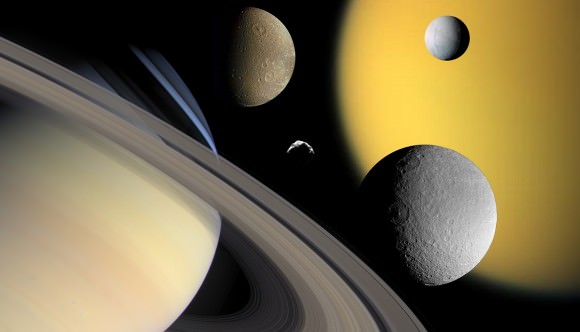
The Inner Large Moons, which orbit within the E Ring, include the larger satellites Mimas Enceladus, Tethys, and Dione. These moons are all composed primarily of water ice and are believed to be differentiated into a rocky core and an icy mantle and crust. The Large Outer Moons, which orbit outside of Saturn’s E Ring, are similar in composition to the Inner Moons – i.e. composed primarily of water ice, and rock.
At 5,150 km (3,200 mi) in diameter and 1,350×1020 kg in mass, Titan is Saturn’s largest moon and comprises more than 96% of the mass in orbit around the planet. Titan is also the only large moon to have its own atmosphere, which is cold, dense, and composed primarily of nitrogen with a small fraction of methane. Scientists have also noted the presence of polycyclic aromatic hydrocarbons in the upper atmosphere, as well as methane ice crystals.
The surface of Titan, which is difficult to observe due to persistent atmospheric haze, shows only a few impact craters, evidence of cryo-volcanoes, and longitudinal dune fields that were apparently shaped by tidal winds. Titan is also the only body in the Solar System aside from Earth to have bodies of liquid on its surface. These take the form of methane–ethane lakes in Titan’s north and south polar regions.
Uranus has 27 known satellites, which are divided into the categories of larger moons, inner moons, and irregular moons (similar to other gas giants). The largest moons of Uranus are, in order of size, Miranda, Ariel, Umbriel, Oberon, and Titania. These moons range in diameter and mass from 472 km (293 mi) and 6.7×1019 kg for Miranda to 1578 km (980.5 mi) and 3.5×1021 kg for Titania. Each of these moons is particularly dark, with low bond and geometric albedos. Ariel is the brightest, while Umbriel is the darkest.
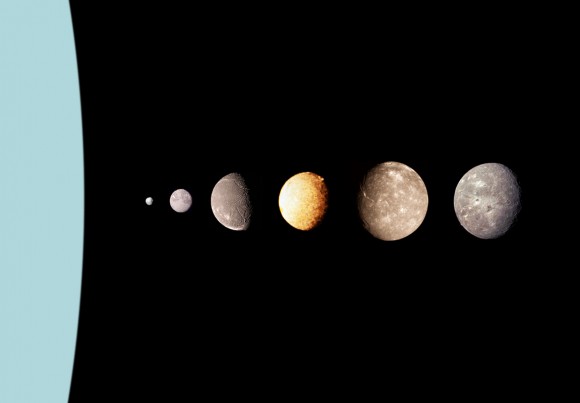
All of the large moons of Uranus are believed to have formed in the accretion disc, which existed around Uranus for some time after its formation or resulted from the large impact suffered by Uranus early in its history. Each one is comprised of roughly equal amounts of rock and ice, except for Miranda, which is made primarily of ice.
The ice component may include ammonia and carbon dioxide, while the rocky material is believed to be composed of carbonaceous material, including organic compounds (similar to asteroids and comets). Their compositions are believed to be differentiated, with an icy mantle surrounding a rocky core.
Neptune has 14 known satellites, all but one of which are named after Greek and Roman deities of the sea (except for S/2004 N 1, which is currently unnamed). These moons are divided into two groups – the regular and irregular moons – based on their orbit and proximity to Neptune. Neptune’s Regular Moons – Naiad, Thalassa, Despina, Galatea, Larissa, S/2004 N 1, and Proteus – are those that are closest to the planet and which follow circular, prograde orbits that lie in the planet’s equatorial plane.
Neptune’s irregular moons consist of the planet’s remaining satellites (including Triton). They generally follow inclined eccentric and often retrograde orbits far from Neptune. The only exception is Triton, which orbits close to the planet, following a circular orbit, though retrograde and inclined.
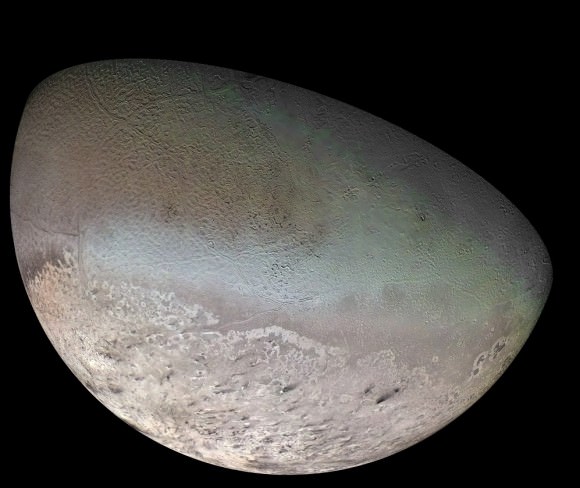
In order of their distance from the planet, the irregular moons are Triton, Nereid, Halimede, Sao, Laomedeia, Neso, and Psamathe – a group that includes both prograde and retrograde objects. With the exception of Triton and Nereid, Neptune’s irregular moons are similar to those of other giant planets and are believed to have been gravitationally captured by Neptune.
With a mean diameter of around 2,700 km (1,678 mi) and a mass of 21,4080 ± 520×1017 kg, Triton is the largest of Neptune’s moons and the only one large enough to achieve hydrostatic equilibrium (i.e. is spherical in shape). At a distance of 354,759 km (220,437 mi) from Neptune, it also sits between the planet’s inner and outer moons.
These moons make up the lion’s share of natural satellites found in the Solar System. However, thanks to ongoing exploration and improvements made in our instrumentation, satellites are being discovered in orbit around minor bodies as well.
Dwarf Planets and Other Bodies:
As already noted, there are several dwarf planets, TNOs, and other bodies in the Solar System that also have their own moons. These consist mainly of the natural satellites that have been confirmed orbiting Pluto, Eris, Haumea, and Makemake. With five orbiting satellites, Pluto has the most confirmed moons (though that may change with further observation).
The largest and closest in orbit to Pluto is Charon. This moon was first identified in 1978 by astronomer James Christy using photographic plates from the United States Naval Observatory (USNO) in Washington, D.C. Beyond Charon lies the four other circumbinary moons – Styx, Nix, Kerberos, and Hydra, respectively.
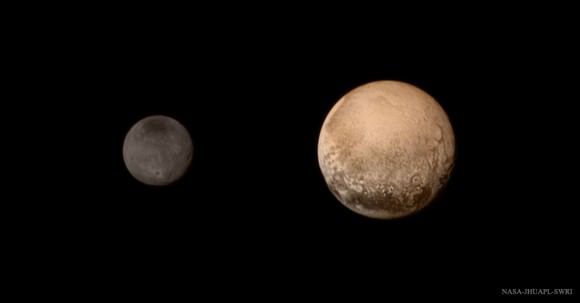
Nix and Hydra were discovered simultaneously in 2005 by the Pluto Companion Search Team using the Hubble Space Telescope. The same team discovered Kerberos in 2011. The fifth and final satellite, Styx, was discovered by the New Horizons spacecraft in 2012 while capturing images of Pluto and Charon.
Charon, Styx, and Kerberos are all massive enough to have collapsed into a spheroid shape under their own gravity. Nix and Hydra, meanwhile, are oblong in shape. The Pluto-Charon system is unusual since it is one of the few systems in the Solar System whose barycenter lies above the primary’s surface. In short, Pluto and Charon orbit each other, causing some scientists to claim that it is a “double-dwarf system” instead of a dwarf planet and an orbiting moon.
In addition, it is unusual in that each body is tidally locked to the other. Charon and Pluto always present the same face to each other, and from any position on either body, the other is always at the same position in the sky or always obscured. This also means that the rotation period of each is equal to the time it takes the entire system to rotate around its common center of gravity.
In 2007, observations by the Gemini Observatory of patches of ammonia hydrates and water crystals on the surface of Charon suggested the presence of active cryo-geysers. This would seem to indicate that Pluto has a warm subsurface ocean and that the core is geologically active. Pluto’s moons are believed to have been formed by a collision between Pluto and a similar-sized body early in the history of the Solar System. The collision released material that consolidated into the moons around Pluto.
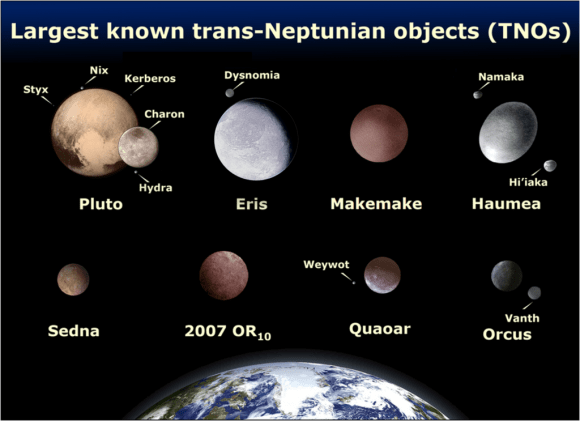
Coming in second is Haumea, which has two known moons – Hi’iaka and Namaka – which are named after the daughters of the Hawaiian goddess. Both were discovered in 2005 by Brown’s team while conducting observations of Haumea at the W.M. Keck Observatory. Hi’iaka, which was initially nicknamed “Rudolph” by the Caltech team, was discovered on January 26th, 2005.
It is the outer, the larger (at roughly 310 km (mi) in diameter), and brighter of the two, and orbits Haumea in a nearly circular path every 49 days. Infrared observations indicate that its surface is almost entirely covered by pure crystalline water ice. Because of this, Brown and his team have speculated that the moon is a fragment of Haumea that broke off during a collision.
Namaka, the smaller and innermost of the two, was discovered on June 30th, 2005, and nicknamed “Blitzen”. It is a tenth the mass of Hi‘iaka and orbits Haumea in 18 days in a highly elliptical orbit. Both moons circle Haumea is highly eccentric orbits. No estimates have been made yet as to their mass.
Eris has one moon called Dysnomia, named after the daughter of Eris in Greek mythology, and was first observed on September 10th, 2005 – a few months after the discovery of Eris. The moon was spotted by a team using the Keck telescopes in Hawaii, who were busy carrying out observations of the four brightest TNOs (Pluto, Makemake, Haumea, and Eris) at the time.
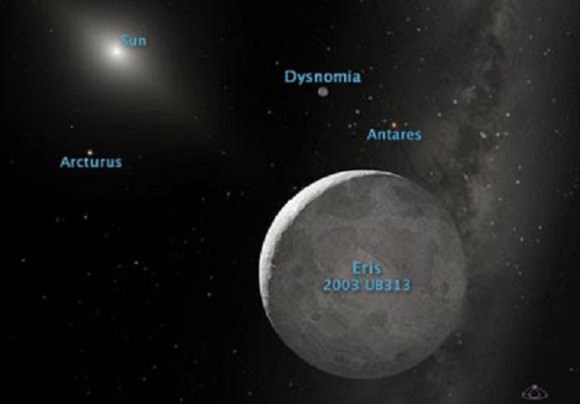
In April 2016, observations using the Hubble Space Telescope‘s Wide Field Camera 3 revealed that Makemake had a natural satellite – which was designated S/2015 (136472) 1 (nicknamed MK 2 by the discovery team). It is estimated to be 175 km (110 mi) km in diameter and has a semi-major axis at least 21,000 km (13,000 mi) from Makemake.
Largest and Smallest Moons:
The title of “largest moon in the Solar System” goes to Ganymede, which measures 5,262.4 kilometers (3,270 mi) in diameter. This not only makes it larger than Earth’s Moon but larger even than the planet Mercury – though it has only half of Mercury’s mass. As for the smallest satellite, that is a tie between S/2003 J 9 and S/2003 J 12. These two satellites, both of which orbit Jupiter, measure about 1 km (0.6 mi) in diameter.
An important thing to note when discussing the number of known moons in the Solar System is that the key word here is “known”. With every passing year, more satellites are being confirmed, and the vast majority of those we now know about were only discovered in the past few decades. As our exploration efforts continue and our instruments improve, we may find that there are hundreds more lurking around out there!
We have written many interesting articles about the moons of the Solar System here at Universe Today. Here’s What is the Biggest moon in the Solar System? What are the Planets of the Solar System?, How Many Moons Does Earth Have?, How Many Moons Does Mars Have?, How Many Moons Does Jupiter Have?, How Many Moons Does Saturn Have?, How Many Moons Does Uranus Have?, How Many Moons Does Neptune Have?
For more information, be sure to check out NASA’s Solar System Exploration page.
We have recorded a whole series of podcasts about the Solar System at Astronomy Cast. Check them out here.
Sources:
Welcome to Jupiter – NASA’s Juno Achieves Orbit around ‘King of the Planets’
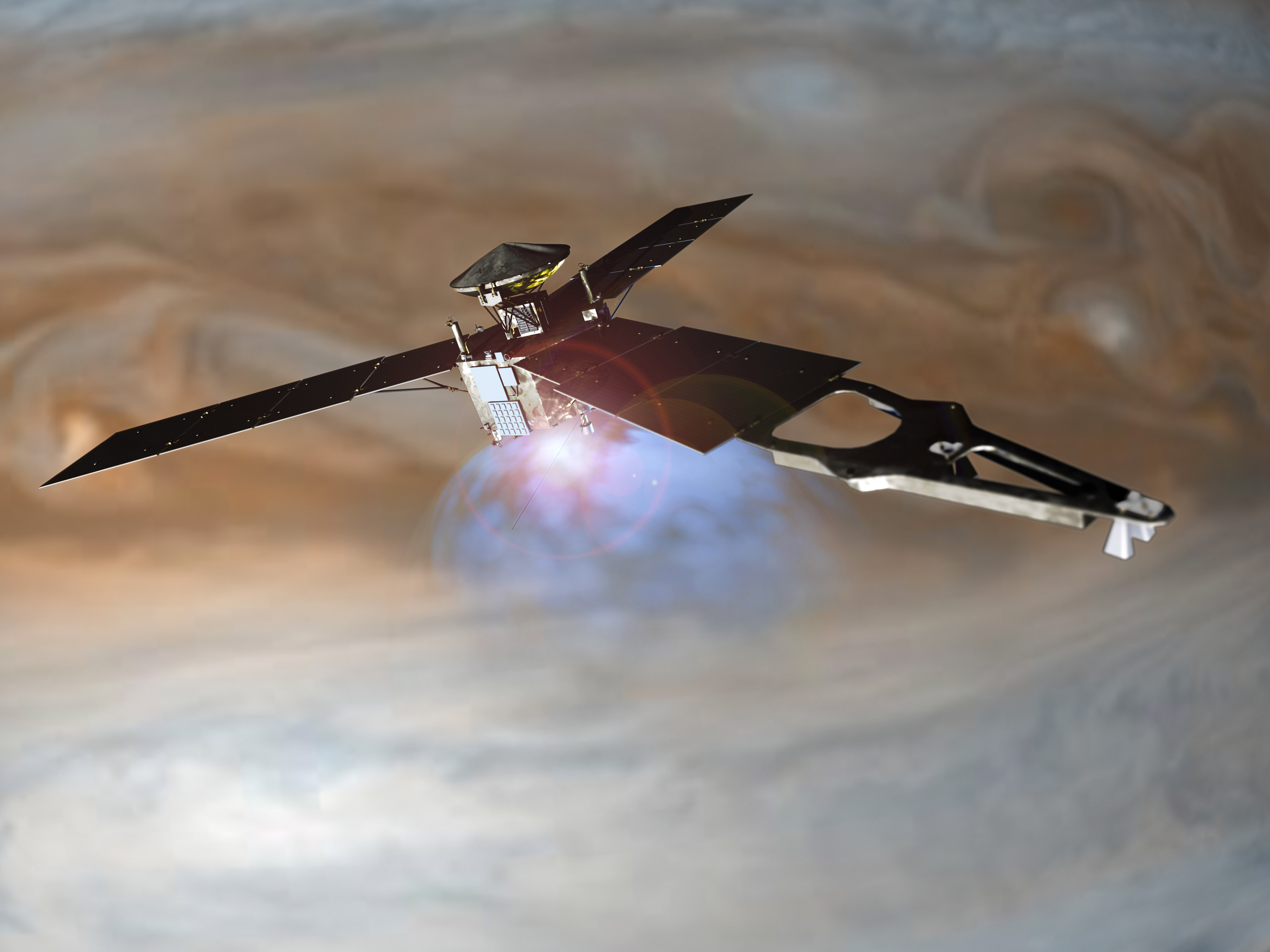

Welcome to Jupiter! NASA’s Juno spacecraft is orbiting Jupiter at this moment!
“NASA did it again!” pronounced an elated Scott Bolton, investigator of Juno from Southwest Research Institute in San Antonio, to loud cheers and applause from the overflow crowd of mission scientists and media gathered at the post orbit media briefing at NASA’s Jet Propulsion Laboratory (JPL) in Pasadena, Calif.
After a nearly five year journey covering 1.7-billion-miles (2.8-billion-kilometers) across our solar system, NASA’s basketball court-sized Juno orbiter achieved orbit around Jupiter, the ‘King of the Planets’ late Monday night, July 4, in a gift to all Americans on our 240th Independence Day and a gift to science to elucidate our origins.
“We are in orbit and now the fun begins, the science,” said Bolton at the briefing. “We just did the hardest thing NASA’s ever done! That’s my claim. I am so happy … and proud of this team.”
And the science is all about peering far beneath the well known banded cloud tops for the first time to investigate Jupiter’s deep interior with a suite of nine instruments, and discover the mysteries of its genesis and evolution and the implications for how we came to be.
“The deep interior of Jupiter is nearly unknown. That’s what we are trying to learn about. The origin of us.”
Solar powered Juno successfully entered a polar elliptical orbit around Jupiter after completing a must-do 35-minute-long firing of the main engine known as Jupiter Orbital Insertion or JOI.
The spacecraft approached Jupiter over its north pole, affording an unprecedented perspective on the Jovian system – “which looks like a mini solar system” – as it flew through the giant planets intense radiation belts in ‘autopilot’ mode.
“The mission team did great. The spacecraft did great. We are looking great. It’s a great day,” Bolton gushes.
Engineers tracking the telemetry received confirmation that the JOI burn was completed as planned at 8:53 p.m. PDT (11:53 p.m. EDT) Monday, July 4.
Juno is only the second probe from Earth to orbit Jupiter and the first solar powered probe to the outer planets. The gas giant is two and a half times more massive than all of the other planets combined.
“Independence Day always is something to celebrate, but today we can add to America’s birthday another reason to cheer — Juno is at Jupiter,” said NASA administrator Charlie Bolden in a statement.
“And what is more American than a NASA mission going boldly where no spacecraft has gone before? With Juno, we will investigate the unknowns of Jupiter’s massive radiation belts to delve deep into not only the planet’s interior, but into how Jupiter was born and how our entire solar system evolved.”
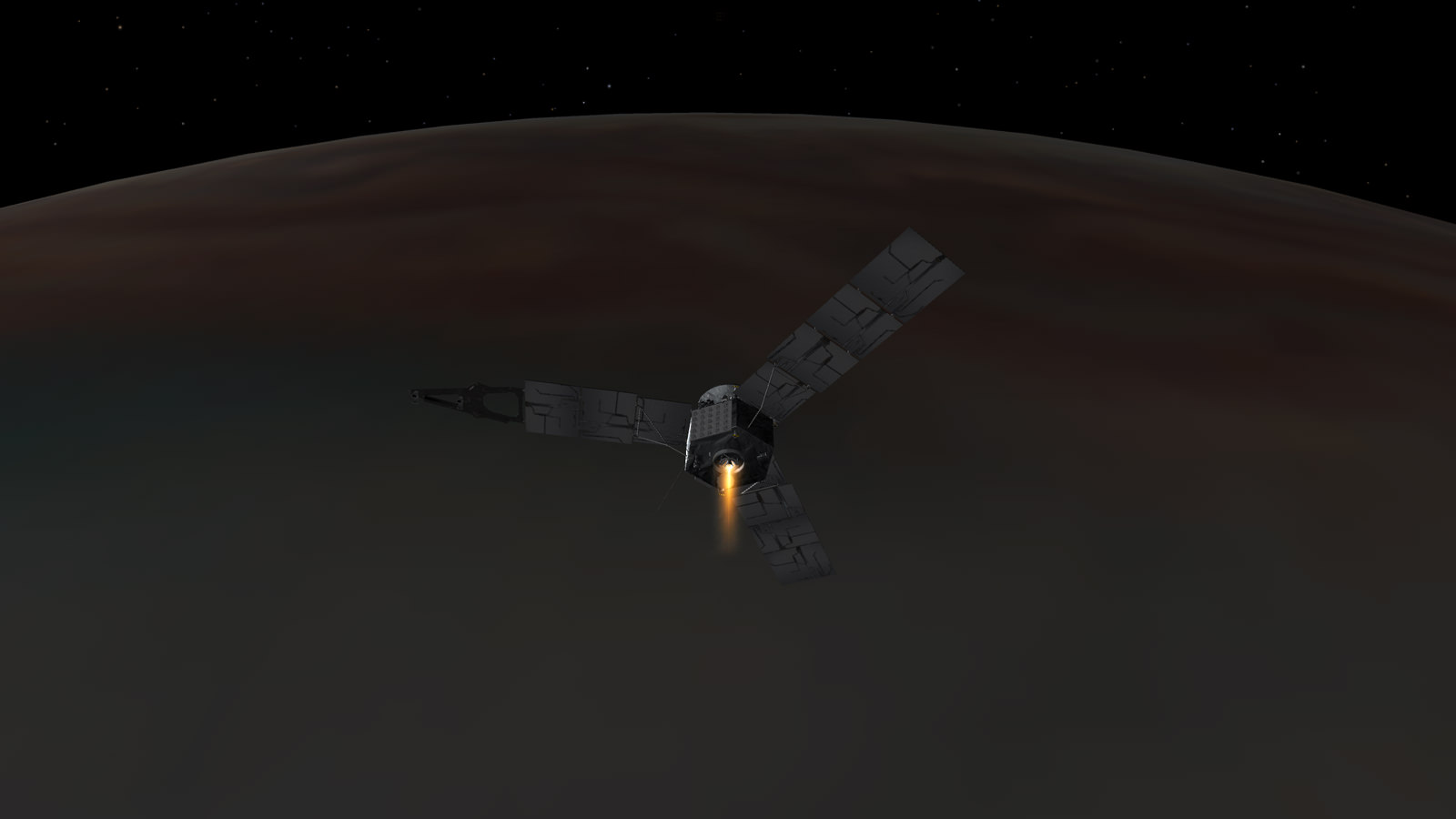
The do-or-die burn of Juno’s 645-Newton Leros-1b main engine started at 8:18 p.m. PDT (11:18 p.m. EDT), which had the effect of decreasing the spacecraft’s velocity by 1,212 miles per hour (542 meters per second) and allowing Juno to be captured in orbit around Jupiter. There were no second chances.
All of the science instruments were turned off on June 30 to keep the focus on the nail-biting insertion maneuver and preserve battery power, said Bolton.
“So tonight through tones Juno sang to us. And it was a song of perfection. After a 1.7 billion mile journey we hit tour burn targets within one second,” Rick Nybakken, Juno project manager from JPL, gleefully reported at the briefing.
“That’s how good our team is! And that’s how well our Juno spacecraft performed tonight.”
To accomplish the burn, the spacecraft first had to adjust it’s attitude to point the engine in the required direction to slow the spacecraft and then simultaneously also had the effect that the life giving solar panels were pointing away from the sun. It the only time during the entire mission at Jupiter that the solar panels were in darkness and not producing energy.
The spacecraft’s rotation rate was also spun up from 2 to 5 revolutions per minute (RPM) to help stabilize it during JOI. Juno is spin stabilized to maintain pointing.
After the burn was complete, Juno was spun down and adjusted to point to the sun before it ran out of battery power.
We have to get the blood flowing through Juno’s veins, Bolton emphasized.
It is equipped with 18,698 individual solar cells over 60 square meters of surface on the solar arrays to provide energy. Juno is spinning like a windmill through space with its 3 giant solar arrays. It is about 540 million miles (869 million kilometers) from Earth.
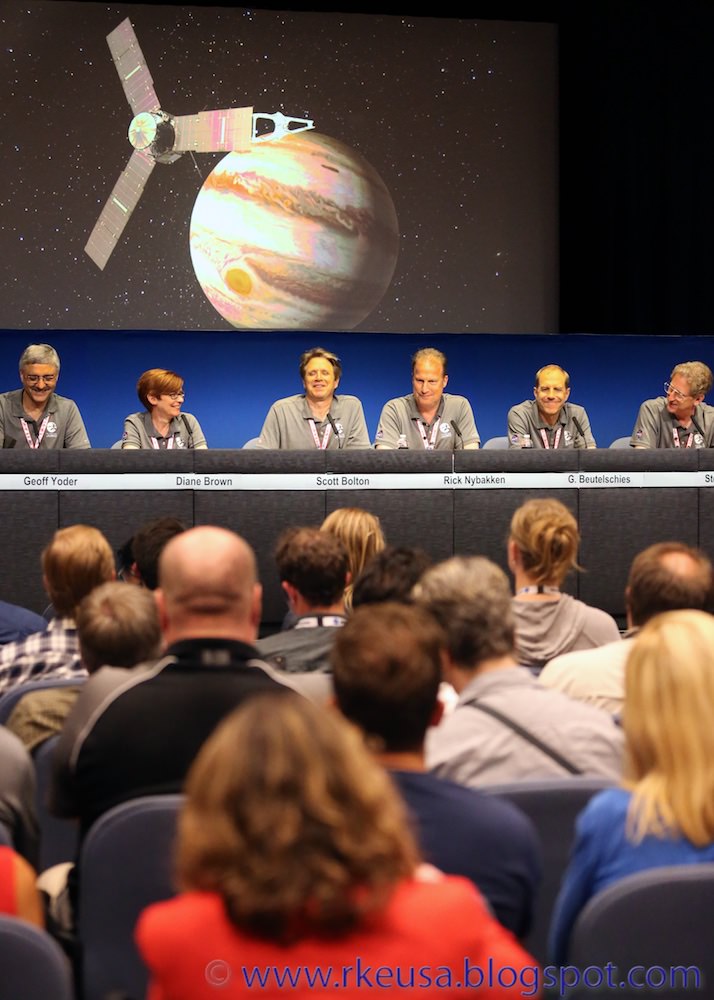
Signals traveling at the speed of light take 48 minutes to reach Earth, said Nybakken.
So the main engine burn, which was fully automated, was already over for some 13 minutes before the first indications of the outcome reach Earth via a series of Doppler signals and tones.
“Tonight, 540 million miles away, Juno performed a precisely choreographed dance at blazing speeds with the largest, most intense planet in our solar system,” said Guy Beutelschies, director of Interplanetary Missions at Lockheed Martin Space Systems.
“Since launch, Juno has operated exceptionally well, and the flawless orbit insertion is a testament to everyone working on Juno and their focus on getting this amazing spacecraft to its destination. NASA now has a science laboratory orbiting Jupiter.”
“The spacecraft is now pointed back at the sun and the antenna back at Earth. The spacecraft performed well and did everything it needed to do,” he reported at the briefing.
“We are looking forward to getting all that science data to Scott and the team.”
“Juno is also the farthest mission to rely on solar power. And although they provide only 1/25th the power at Earth, they still provide over 500 watts of power at Jupiter,” said Nybakken.
Initially the spacecraft enters a long, looping polar orbit lasting about 53 days. That highly elliptical orbit will be trimmed to 14 days for the regular science orbits.
The orbits are designed to minimize contact with Jupiter’s extremely intense radiation belts. The nine science instruments are shielded inside a ½ thick vault built of Titanium to protect them from the utterly deadly radiation of some 20,000,000 rads.
During a 20 month long science mission – entailing 37 orbits lasting 14 days each – the probe will plunge to within about 3000 miles of the turbulent cloud tops and collect unprecedented new data that will unveil the hidden inner secrets of Jupiter’s origin and evolution.
But the length and number of the science orbits has changed since the mission was launched almost 5 years ago in 2011.
Originally Juno was planned to last about one year with an orbital profile involving 33 orbits of 11 days each.
I asked the team to explain the details of how and why the change from 11 to 14 days orbits and increasing the total number of orbits to 37 from 33, especially in light of the extremely harsh radiation hazards?
“The original plan of 33 orbits of 11 days was an example but there were other periods that would work,” Bolton told Universe Today.
“What we really cared about was dropping down over the poles and capturing each longitude, and laying a map or net around Jupiter.”
“Also, during the Earth flyby we went into safe mode. And as we looked at that it was a hiccup by the spacecraft but it actually behaved as it should have.”
“So we said well if that happened at Jupiter we would like to be able to recover and not lose an orbit. So we started to look at the timeline of how long it took to recover, and did we want to add a couple of days to the orbit for conservatism – to ensure the science mission.”
“So it made sense to add 3 days. It didn’t change the science and it made the probability of success even greater. So that was the basis of the change.”
“We also evaluated the radiation. And it wasn’t much different. Juno is designed to take data at a very low risk. The radiation slowly accumulates at the start. As you get to the later part of the mission, it gets a faster and faster accumulation.”
“So we still retained that conservatism as well and the overall radiation dose was pretty much the same,” Bolton explained.
“The radiation we accumulate is not just the more time you spend the more radiation,” Steve Levin, Juno Project Scientist at JPL, told Universe Today.
“Each time we come in close to the planet we get a dose of radiation. Then the spacecraft is out far from Jupiter and is relatively free from that radiation until we come in close again.”
“So just changing from 11 to 14 day orbits does not mean we get more radiation because you are there longer.”
“It’s really the number of times we come in close to Jupiter that determines how much radiation we are getting.”
Juno is the fastest spacecraft ever to arrive at Jupiter and was moving at over 165,000 mph relative to Earth and 130,000 mph relative to Jupiter at the moment of JOI.
Juno’s principal goal is to understand the origin and evolution of Jupiter.
“With its suite of nine science instruments, Juno will investigate the existence of a solid planetary core, map Jupiter’s intense magnetic field, measure the amount of water and ammonia in the deep atmosphere, and observe the planet’s auroras. The mission also will let us take a giant step forward in our understanding of how giant planets form and the role these titans played in putting together the rest of the solar system. As our primary example of a giant planet, Jupiter also can provide critical knowledge for understanding the planetary systems being discovered around other stars,” according to a NASA description.
The $1.1 Billion Juno was launched on Aug. 5, 2011 from Cape Canaveral, Florida atop the most powerful version of the Atlas V rocket augmented by 5 solid rocket boosters and built by United Launch Alliance (ULA). That same Atlas V 551 version just launched MUOS-5 for the US Navy on June 24.
The Juno spacecraft was built by prime contractor Lockheed Martin in Denver.
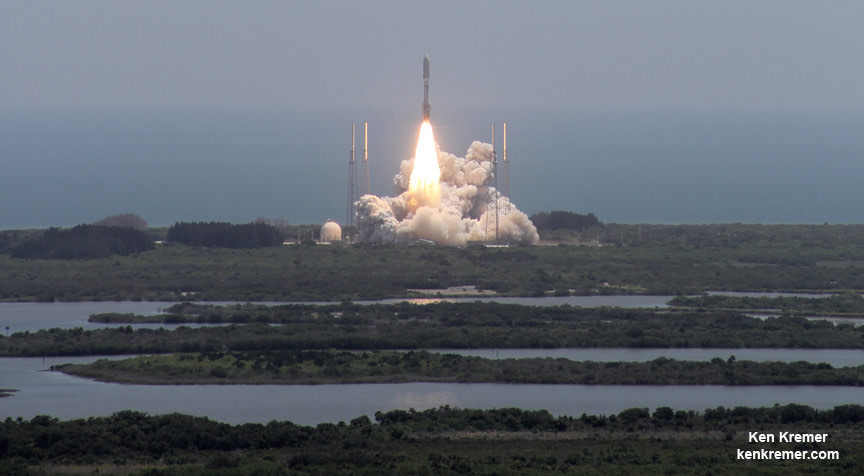
The last NASA spacecraft to orbit Jupiter was Galileo in 1995. It explored the Jovian system until 2003.
Bolton also released new views of Jupiter taken by JunoCam – the on board public outreach camera that snapped a final gorgeous view of the Jovian system showing Jupiter and its four largest moons, dancing around the largest planet in our solar system.
The newly released color image was taken on June 29, 2016, at a distance of 3.3 million miles (5.3 million kilometers) from Jupiter – just before the probe went into autopilot mode.
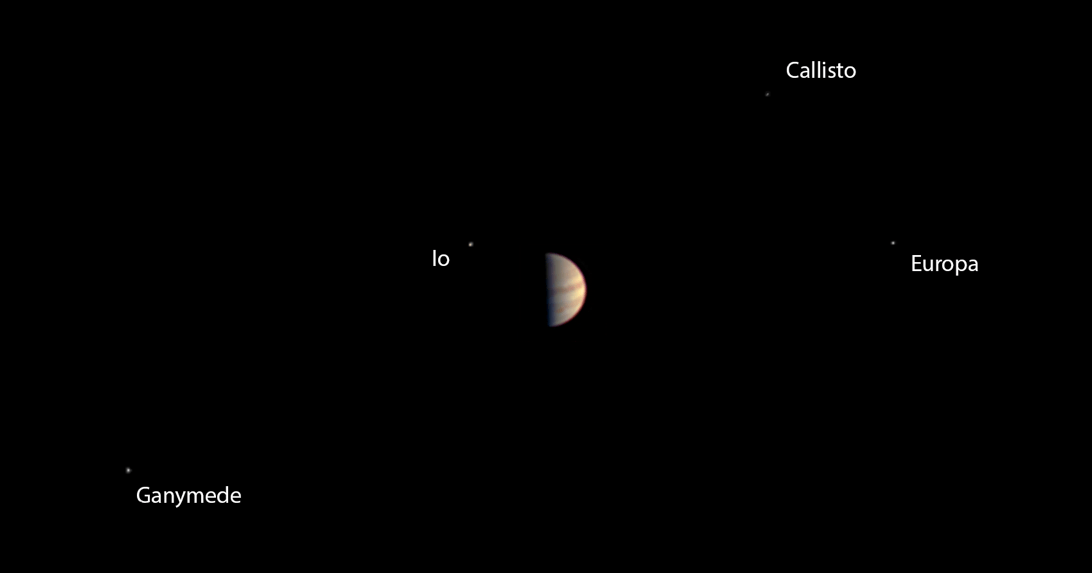
It shows a dramatic view of the clouds bands of Jupiter, dominating a spectacular scene that includes the giant planet’s four largest moons — Io, Europa, Ganymede and Callisto.
Scott Bolton and NASA also released this spectacular new time-lapse JunoCam movie at today’s briefing showing Juno’s approach to Jupiter and the Galilean Moons.
Watch and be mesmerized -“for humanity, our first real glimpse of celestial harmonic motion” says Bolton.
Video caption: NASA’s Juno spacecraft captured a unique time-lapse movie of the Galilean satellites in motion about Jupiter. The movie begins on June 12th with Juno 10 million miles from Jupiter, and ends on June 29th, 3 million miles distant. The innermost moon is volcanic Io; next in line is the ice-crusted ocean world Europa, followed by massive Ganymede, and finally, heavily cratered Callisto. Galileo observed these moons change position with respect to Jupiter over the course of a few nights. From this observation he realized that the moons were orbiting mighty Jupiter, a truth that forever changed humanity’s understanding of our place in the cosmos. Earth was not the center of the Universe. For the first time in history, we look upon these moons as they orbit Jupiter and share in Galileo’s revelation. This is the motion of nature’s harmony. Credits: NASA/JPL-Caltech/MSSS
Along the 5 year journey to Jupiter, Juno made a return trip to Earth on Oct. 9, 2013 for a flyby gravity assist speed boost that enabled the trek to the Jovian system.
During the Earth flyby (EFB), the science team observed Earth using most of Juno’s nine science instruments including, JunoCam, since the slingshot also served as an important dress rehearsal and key test of the spacecraft’s instruments, systems and flight operations teams.
The JunoCam images will be made publicly available to see and process.
During the Earth flyby, Junocam snapped some striking images of Earth as it sped over Argentina, South America and the South Atlantic Ocean and came within 347 miles (560 kilometers) of the surface.
For example a dazzling portrait of our Home Planet high over the South American coastline and the Atlantic Ocean gives a hint of what’s to come from Jupiter’s cloud tops. See our colorized Junocam mosaic of land, sea and swirling clouds, created by Ken Kremer and Marco Di Lorenzo
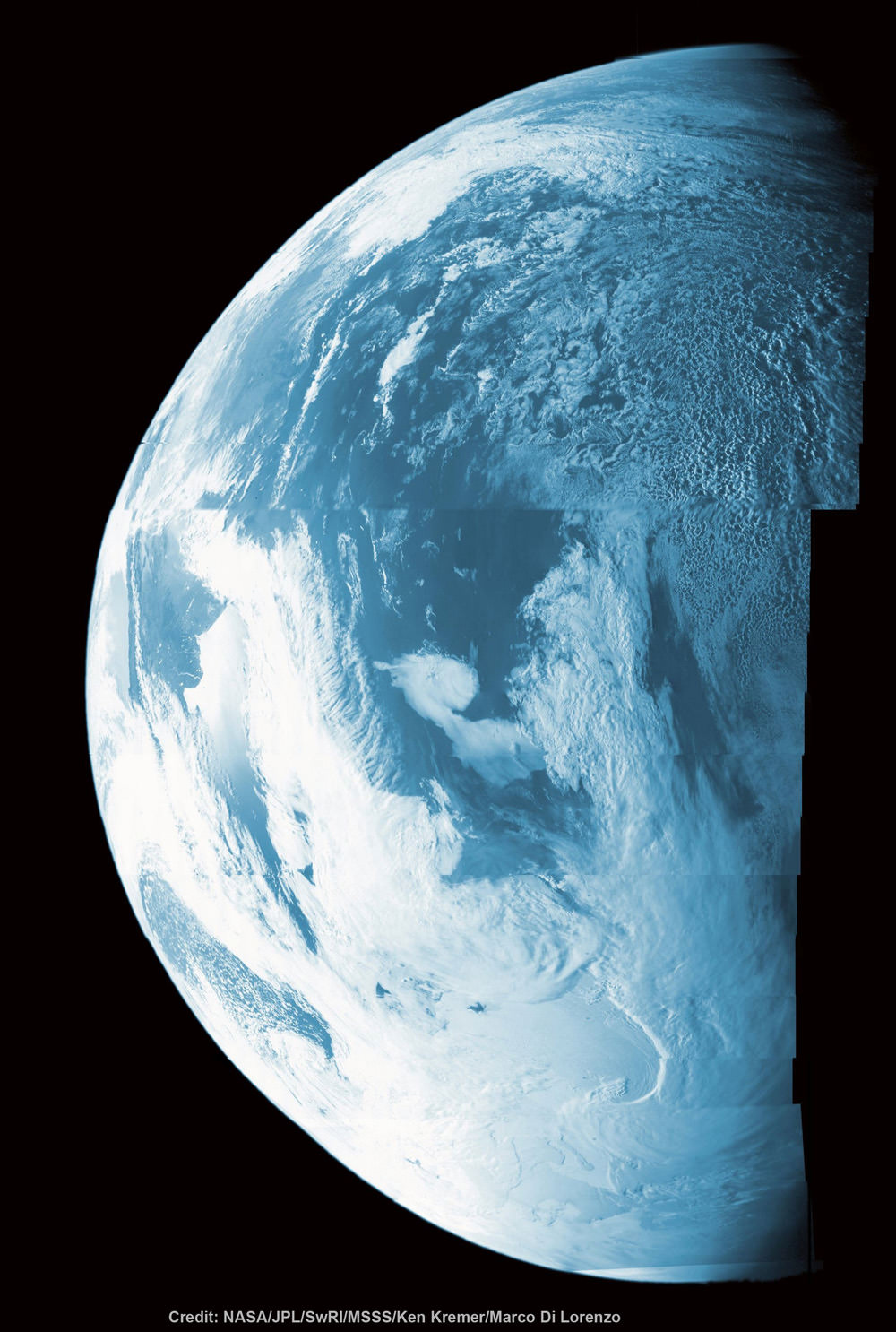
Stay tuned here for Ken’s continuing Earth and Planetary science and human spaceflight news.
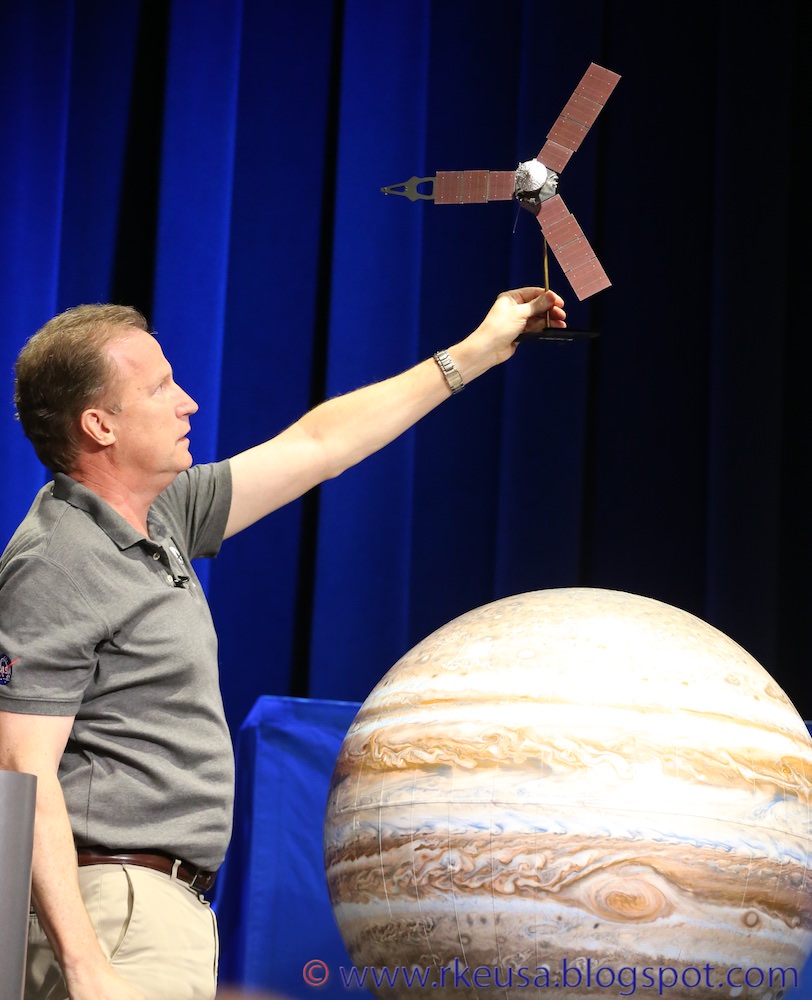
7 Days Out From Orbital Insertion, NASA’s Juno Images Jupiter and its Largest Moons
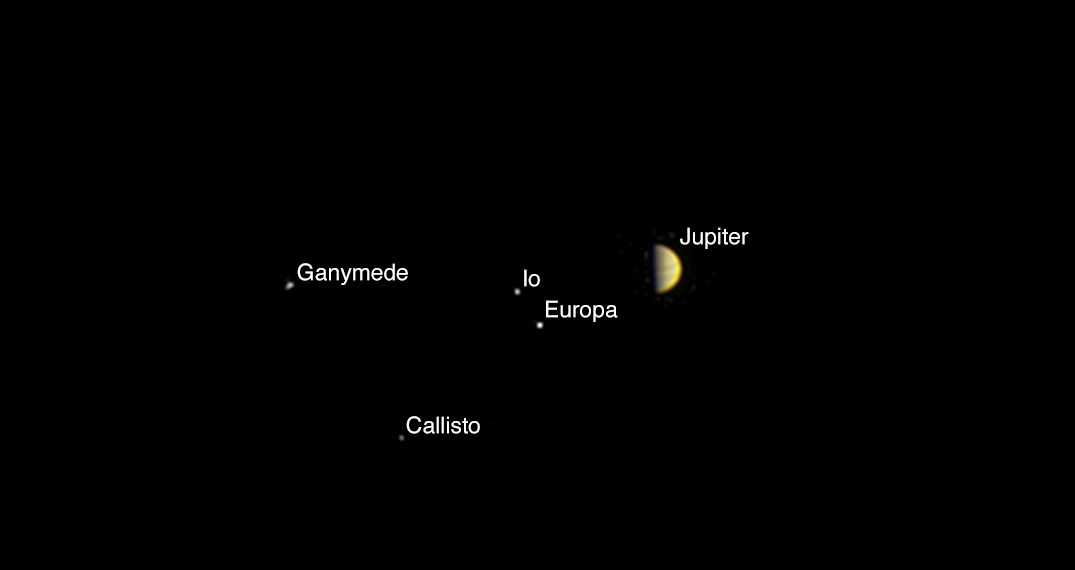

Now just 7 days out from a critical orbital insertion burn, NASA’s Jupiter-bound Juno orbiter is closing in fast on the massive gas giant. And as its coming into focus the spacecraft has begun snapping a series of beautiful images of the biggest planet and its biggest moons.
In a newly released color image snapped by the probes educational public outreach camera named Junocam, banded Jupiter dominates a spectacular scene that includes the giant planet’s four largest moons — Io, Europa, Ganymede and Callisto.
Junocam’s image of the approaching Jovian system was taken on June 21, 2016, at a distance of 6.8 million miles (10.9 million kilometers) and hints at the multitude of photos and science riches to come from Juno.
“Juno on Jupiter’s Doorstep,” says a NASA description. “And the alternating light and dark bands of the planet’s clouds are just beginning to come into view,” revealing its “distinctive swirling bands of orange, brown and white.”
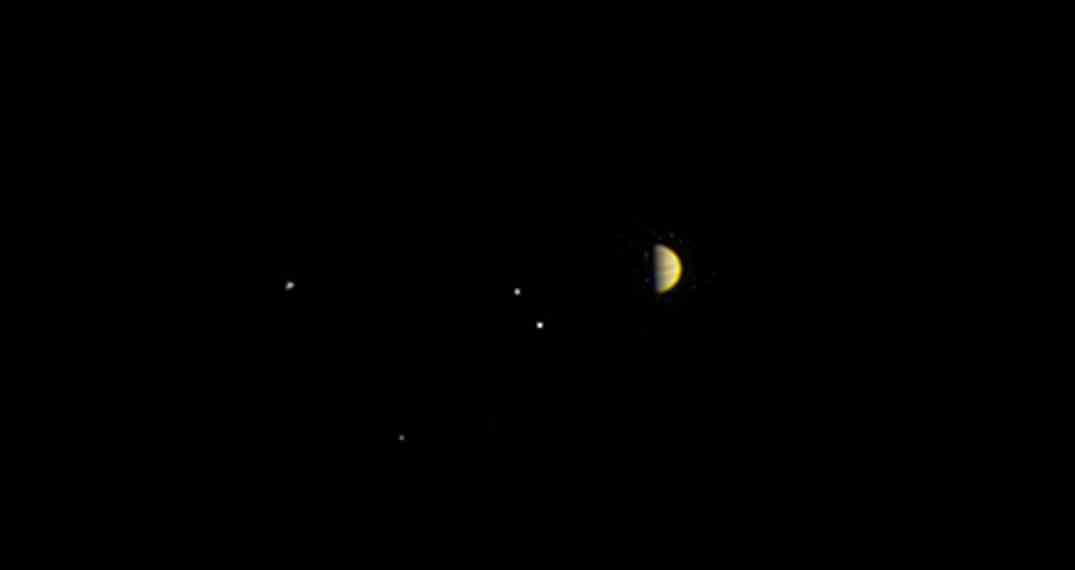
Rather appropriately for an American space endeavor, the fate of the entire mission hinges on do or die ‘Independence Day’ fireworks.
On the evening of July 4, Juno must fire its main engine for 35 minutes.
The Joy of JOI – or Jupiter Orbit Insertion – will place NASA’s robotic explorer into a polar orbit around the gas giant.
The approach over the north pole is unlike earlier probes that approached from much lower latitudes nearer the equatorial zone, and thus provide a perspective unlike any other.
After a five-year and 2.8 Billion kilometer (1.7 Billion mile) outbound trek to the Jovian system and the largest planet in our solar system and an intervening Earth flyby speed boost, the moment of truth for Juno is now inexorably at hand.

And preparations are in full swing by the science and engineering team to ensure a spectacular Fourth of July fireworks display.
The team has been in contact with Juno 24/7 since June 11 and already uplinked the rocket firing parameters.
Signals traveling at the speed of light take 10 minutes to reach Earth.
The protective cover that shields Juno’s main engine from micrometeorites and interstellar dust was opened on June 20.
“And the software program that will command the spacecraft through the all-important rocket burn was uplinked,” says NASA.
The pressurization of the propulsion system is set for June 28.
“We have over five years of spaceflight experience and only 10 days to Jupiter orbit insertion,” said Rick Nybakken, Juno project manager from NASA’s Jet Propulsion Laboratory in Pasadena, California, said in a statement.
“It is a great feeling to put all the interplanetary space in the rearview mirror and have the biggest planet in the solar system in our windshield.”
On the night of orbital insertion, Juno will fly within 2,900 miles (4,667 kilometers) of the Jovian cloud tops.
All instruments except those critical for the JOI insertion burn on July 4, will be tuned off on June 29. That includes shutting down Junocam.
“If it doesn’t help us get into orbit, it is shut down,” said Scott Bolton, Juno’s principal investigator from the Southwest Research Institute in San Antonio.
“That is how critical this rocket burn is. And while we will not be getting images as we make our final approach to the planet, we have some interesting pictures of what Jupiter and its moons look like from five-plus million miles away.”
During a 20 month long science mission – entailing 37 orbits lasting 11 days each – the probe will plunge to within about 3000 miles of the turbulent cloud tops and collect unprecedented new data that will unveil the hidden inner secrets of Jupiter’s origin and evolution.
“Jupiter is the Rosetta Stone of our solar system,” says Bolton. “It is by far the oldest planet, contains more material than all the other planets, asteroids and comets combined and carries deep inside it the story of not only the solar system but of us. Juno is going there as our emissary — to interpret what Jupiter has to say.”
During the orbits, Juno will probe beneath the obscuring cloud cover of Jupiter and study its auroras to learn more about the planet’s origins, structure, atmosphere and magnetosphere.
Junocam has already taken some striking images during the Earth flyby gravity assist speed boost on Oct. 9, 2013.
For example the dazzling portrait of our Home Planet high over the South American coastline and the Atlantic Ocean.
For a hint of what’s to come, see our colorized Junocam mosaic of land, sea and swirling clouds, created by Ken Kremer and Marco Di Lorenzo.
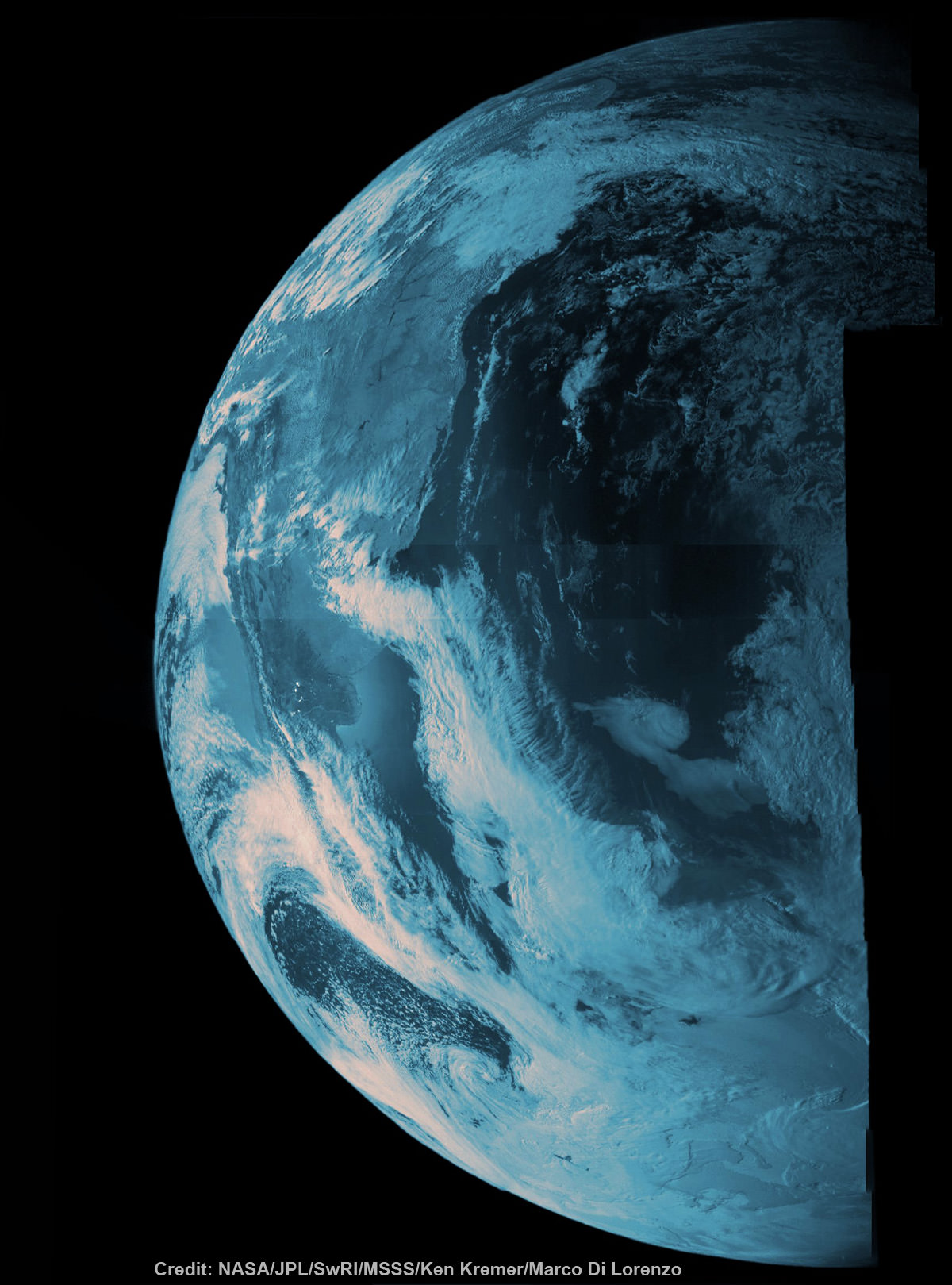
As Juno sped over Argentina, South America and the South Atlantic Ocean it came within 347 miles (560 kilometers) of Earth’s surface.
During the flyby, the science team observed Earth using most of Juno’s nine science instruments since the slingshot also serves as an important dress rehearsal and key test of the spacecraft’s instruments, systems and flight operations teams.
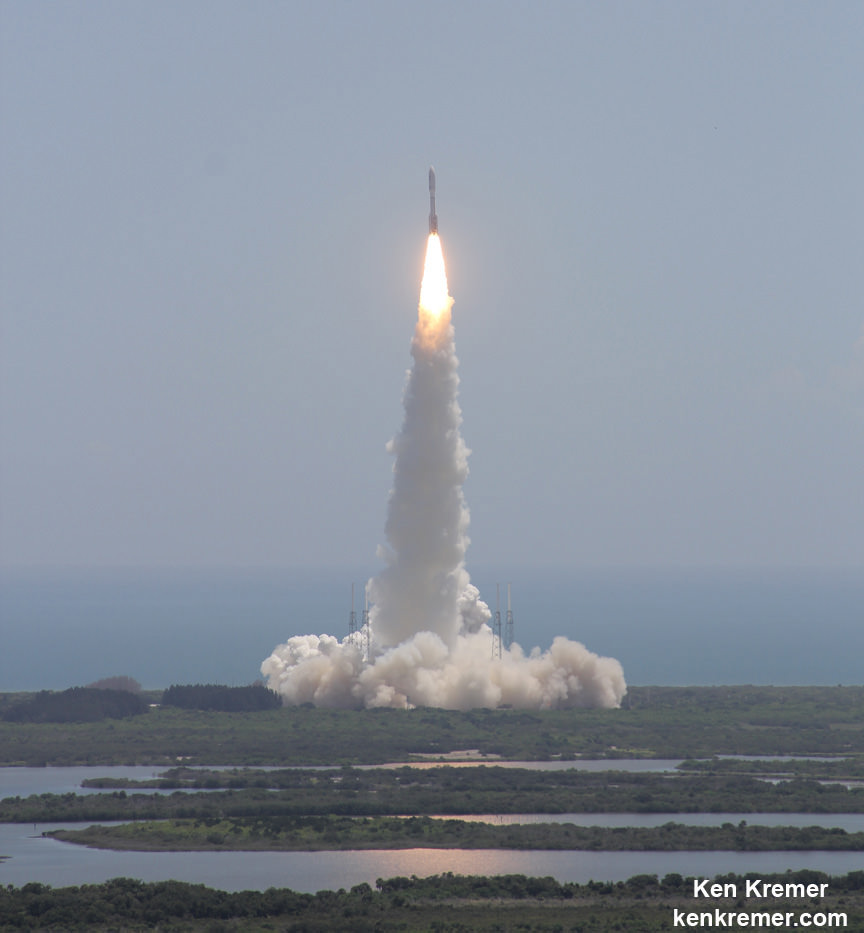
The $1.1 Billion Juno was launched on Aug. 5, 2011 from Cape Canaveral, Florida atop the most powerful version of the Atlas V rocket augmented by 5 solid rocket boosters and built by United Launch Alliance (ULA). That same Atlas V 551 version just launched MUOS-5 for the US Navy on June 24.
Stay tuned here for Ken’s continuing Earth and Planetary science and human spaceflight news.
Ken Kremer

How Do We Terraform Jupiter’s Moons?
Continuing with our “Definitive Guide to Terraforming“, Universe Today is happy to present to our guide to terraforming Jupiter’s Moons. Much like terraforming the inner Solar System, it might be feasible someday. But should we?
Fans of Arthur C. Clarke may recall how in his novel, 2010: Odyssey Two (or the movie adaptation called 2010: The Year We Make Contact), an alien species turned Jupiter into a new star. In so doing, Jupiter’s moon Europa was permanently terraformed, as its icy surface melted, an atmosphere formed, and all the life living in the moon’s oceans began to emerge and thrive on the surface.
As we explained in a previous video (“Could Jupiter Become a Star“) turning Jupiter into a star is not exactly doable (not yet, anyway). However, there are several proposals on how we could go about transforming some of Jupiter’s moons in order to make them habitable by human beings. In short, it is possible that humans could terraform one of more of the Jovians to make it suitable for full-scale human settlement someday.

